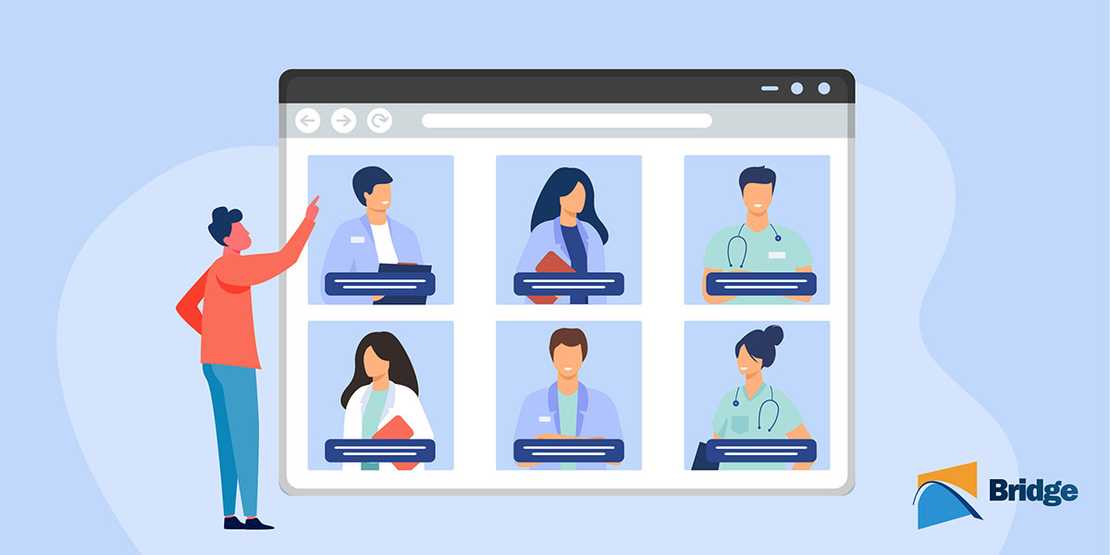A Digital Front Door Platform Can Help You Keep Up With the Consumerization of Healthcare
- Kirsty Watson
- April 02, 2021

We live in a digital world. Communicating with businesses in day-to-day life is as easy as grabbing a smartphone. Ordering products and requesting services takes mere minutes. Entertainment, habits, and other lifestyle choices can all be customized and arranged using different mobile apps, while online reviews help shape which businesses or products are chosen.
Many retail and financial institutions[¹] have continuously shaped customers’ expectations by providing both “in-person” and streamlined and secure online options, depending on the customer’s needs.
Why should visiting the doctor’s office be any different?
Patients are looking for these same customizable, convenient features in the management of their health. Younger generations especially[²] are prioritizing patient-centric features that align with the comfort and convenience they are accustomed to. These patients may be inclined to leave established practices that have not digitized, creating a lapse in care and resulting in a loss of revenue.
What is the Consumerization of Healthcare?
The consumerization of healthcare is a growing trend that puts patients in the driver’s seat of their healthcare. Consumerization, defined as the “protection of the interests of consumers,” will continue to affect[³] healthcare in two key ways: convenience of care and empowerment of the patient. Technology has played a major part in this trend, as well as the autonomy consumers have become accustomed to in other major institutions. Retail clinics, which offer affordable and efficient solutions for minor health issues, have also shaped patient behavior and expectations[⁴]. As these trends progress, if healthcare organizations are to remain competitive, they must strive to validate and meet patient needs.
Quality and Convenience
As a result of the consumerization of healthcare, patients are increasingly demanding both quality and convenience. A patient-centric practice is one that takes into consideration what current patients need and want, inside and out of the practice. Patients value both in-person and digital healthcare experiences. While most patients prefer to build relationships with their providers and favor continuity of care, three-quarters[⁵] of patients also believe that practices utilizing mobile features provide a more convenient experience.
Additionally, part of providing quality care for patients is to make the privacy and security of patients[⁶] a top priority. It is vital to comply with all current HIPAA regulations, especially regarding digital and electronic patient interactions. As more competitors enter the market, practices must continue to prove to patients that their information is safe and secure.
In order for medical practices to stay ahead of the consumerization of healthcare, it is important to focus on both quality and convenience, providing patients with a trustworthy, cohesive experience that will ultimately have a positive impact on their health.
Choosing a Provider
The consumerization of healthcare has affected how patients choose their providers as well. Two of the[⁷] most requested features are automated patient appointment reminders and a patient scheduling portal. Other in-demand features include telehealth options, prescription refill solutions, the ability to chat with practitioners without a formal appointment safely, and accessing lab results.
Online presence is also key when choosing a provider in today’s market. Research indicates that potential patients are most likely to search for healthcare practices online[⁸]. As with other businesses and products, patients take into account the positive and negative reviews of the doctors and practices they are considering. Practices must prove that they are aware of what current patients need and are addressing those needs. A well-advertised Healthcare Digital Front Door will give potential patients peace of mind that the practice can provide what they need.
A Digital Front Door Platform
A comprehensive digital front door platform provides patients with a streamlined means of accessing all of the tools and features that empower them to engage with their healthcare proactively and independently. A digital front door platform addresses the issue of convenience and quality by offering a single point-of-access for multiple services. For example, patients can schedule an in-person or telehealth visit, or simply message their practitioner, all from the same easy-to-use portal with a single set of logins. Furthermore, patients can trust that every digital interaction is HIPAA compliant and completely secure.
A digital front door platform also keeps practices competitive by going beyond simply directing patients to a patient portal. When successfully implemented, it gives patients access to a connected ecosystem of digital platforms to provide them with a cohesive, convenient experience. These platforms can adapt and change as patients’ needs continue to evolve, empowering patients to take more control of their healthcare.
- Accenture. (2019) Accenture 2019 Digital Health Consumer Survey. [online] accenture.com. Available at: https://www.accenture.com/_acnmedia/pdf-94/accenture-2019-digital-health-consumer-survey.pdf
- Personal Connected Health Alliance. (2019). Defining Consumerization in Healthcare. [online] Personal Connected Health Alliance. Available at: https://www.pchalliance.org/news/defining-consumerization-healthcare
- McKinsey & Company. (2018). Healthcare consumerism 2018: An update on the journey. [online] McKinsey Available at: https://www.mckinsey.com/industries/healthcare-systems-and-services/our-insights/healthcare-consumerism-2018.
- Appventurez. (2020). The Rising Adoption of mHealth Apps in Healthcare Industry. [online] Appventurez. Available at: https://www.appventurez.com/blog/mobile-applications-in-healthcare/
- Accenture. (2020). How Can Leaders Make Recent Digital Health Gains Last? [online] . Accenture. Available at: https://www.accenture.com/_acnmedia/PDF-130/Accenture-2020-Digital-Health-Consumer-Survey-US.pdf.
- Vogel, M.M.E., Eitz, K.A. and Combs, S.E. (2021). Web-Based Patient Self-Reported Outcome After Radiotherapy in Adolescents and Young Adults With Cancer: Survey on Acceptance of Digital Tools. [online] JMIR mHealth and uHealth. Available at: https://mhealth.jmir.org/2021/1/e19727
- Isabel Healthcare (2020). Learn the best strategies for acquiring patients via modern digital front door. [online] go.beckershospitalreview.com. Available at: https://go.beckershospitalreview.com/learn-the-best-strategies-for-acquiring-patients-via-modern-digital-front-door
